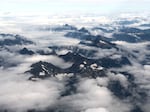Hotter and more intense fires are likely coming to the Pacific Northwest’s cooler and wetter forests. That’s from new research led by an Oregon State University scientist.

Parts of the Cascades Region of Washington and Oregon are going to become increasingly susceptible to increased fire activity in the coming decades, according to new research.
Brian Bull / KLCC
Comprehensive wildfire simulations for over a 23-million acre stretch of forest show that for a 30-year period beginning in 2035, Oregon’s western Cascades and Washington’s north Cascades — as well as the Puget Lowlands and Olympic Mountains — could see at least twice as much fire activity as seen in the last 30 years.
“It’s time to start thinking about things that could counteract those climate effects,” said Alex Dye. He’s a research associate with OSU’s College of Forestry, and the lead author on the study published in the latest edition of JGR Biogeosciences.
“As we move forward into this research, the logical next steps are to explore those other pieces like ignition and vegetation changes, and how that can all interact with climate to further refine these future fire risk projections,” added Dye.
To many residents of the Pacific Northwest, these predictions may be surprising given the dense lushness of these areas. But researchers say modeling indicates that as the climate continues to get warmer and drier, fires in these cool and wet spaces will increase in probability, size, and number.
“Those forests are so ingrained in the natural history and the socioeconomics and the lived experience of being in the western PNW,” Dye told KLCC. “So adding in more fire that affects those resources from a variety of directions is a big deal and is something to think about as we move into the next 30 years.”
Dye said that it can be challenging to assess fire probability in an environment where there isn’t much empirical information about the fire history to build models. And the comparative infrequency of fire makes it easy for the general public to regard the PNW “Westside” as a low-risk area. But recent conflagrations like those observed around Labor Day 2020 — which also led to Oregon’s worst wildfire season on record — can show what can happen when fires do erupt in these areas.
Affected resources range from drinking water to timber, as well as residents and wildlife.
Dye’s work is a collaboration with Matt Reilly, Karin Riley, John Kim, and Becky Kerns of the U.S. Forest Service, and OSU co-researchers Andy McEvoy and Rebecca Lemons. The U.S.F.S team members work at the Western Wildland Environmental Threat Assessment Center, the Pacific Northwest Research Station, or the Rocky Mountain Research Center.
The Western Wildland Environmental Threat Assessment Center and the Pacific Northwest Research Station Westside Fire Initiative supported the research.
Copyright 2024, KLCC.